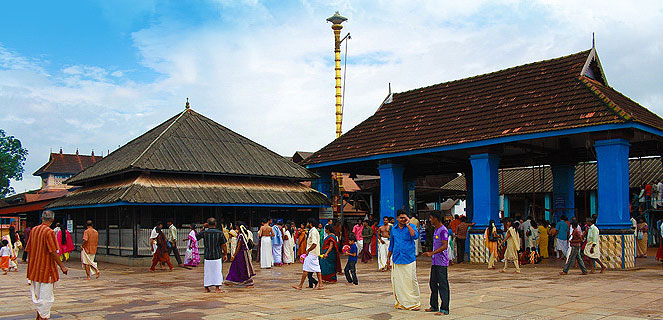
|
You are on the page: Home page ➤ Photo galleries of India ➤ Kerala ➤ Bhagavathy temple, Chottanikkara
|
Bhagavathy temple, Chottanikkara
Chottanikkara is located nearly 8 kms east from Thrippunithura town. There Chottanikkara Goddesses remains in triple forms - as Saraswathy, Durga and Mahalakshmi.
The Aryans had made delightful temples in the remote past to worship Gods and Goddesses, because they believed in the existence of such deities. At the same time, in the village of Chottanikkara hill there lived a group of people, who belonged to the hill-tribes, believed in the existence of a Force of Nature which controls the forests, rivers, floods, rains, lightning, thunder, wild animals and human beings. They called it ‘Sakthi’ which had no form or shape. They also believed that Sakthi possessed the power of doing things, good as well as bad things to the people and they used to propitiate it by offering food to get blessings and favours.
 |
One day they saw a piece of rock in a pool of blood among the trees in the forest. The tribes personified that rock and attributed having ‘Sakthi’ and began to worship it. The kindled fire and offered food, sometimes toddy and flesh and danced around in praise of the Goddess.
The mythological story about the origin of the temple is as follows.
In the past the place was a dense forest. A tribeman named Kannappan lived there with his daughter. His wife had already died prematurely. He was a theist. His favourite Goddess was Sakthi. He pleased the ferocious Goddess by offering animal sacrifice. He did this almost daily without interruption. He stole cows from the nearby villages. He gave importance to please the Goddess than anything else in life. So he believed that the killing of cows was as holy as offering it to the Goddess. But his daughter did not like it at all. She looked after a calf which Kannappan had brought once for sacrifice. Now it had grown up. It was her pet animal.
One day Kannappan had no animal to offer to his Goddess. He became sad. He wanted his daughter to give him her cow for the sacrifice, but she did not pay any attention to it Moreover she requested her father to take herself for the sacrifice instead of her innocent pet. She loved the animal more than her life. Kannappan accepted his failure. He thought about the cruelty of killing the animals and the sin it would bring to him. He repented of what he had done and craved for atonement. He sat at the place where he had done the animal sacrifice and wept bitterly. Then he saw at a distance his daughter’s cow lying and chewing the cud. Since he became weak and exhausted he lay down and slept.
Next morning he saw a big stone in the place of the cow. The cow had already disappeared. How wonderful! The cow which had changed his mind, turned into a rock. He called his daughter
and they together prayed for Kali’s help. The Goddess was pleased with the father and daughter. Their life became fruitful. They became free from all sins and lead a happy life.
The place where the cow had lain was known as ‘Pavizhamallithara’. The cow was actually the Goddess Mahalakshmi. The Lord Maha Vishnu had given Kannappan an opportunity to have a divine sight of Lakshmi-Narayana form. Later, the place where the animal sacrifice had been performed, became the abode of ‘Kizhkavil Bhagavathy’. It is believed that the two temples have got the same Goddess in two different forms; in other words they can be called the two sides of the same coin.
During the 9th century when the Brahmin supremacy was at its zenith, the administration of the temple fell into the hands of Brahmins. The vedic system of rituals were followed by the ‘ Edattu Nampoothiri’ and later this Nampoothiri family had got the right for priesthood at the Chottanikkara temple. The temple progressed day by day and became the only major temple in Thrippunithura, which attracted a large number of devotees from far and wide. The combined effort of two ‘manas’, Pallippuram and Ayinikkatt, made the temple prosperous and rich. Certain other Nampoothiri families also gave money and land to the temple.
Once Vilwamangalathu Swamiyar was able to see the Goddess Maha Lakshmi with Maha Vishnu, with all paraphernalia, a rare opportunity for the worshippers, on the day of Makom in the month of Kumbhom (February / March). From this time onwards Makom worshipping become an important day of the temple. It is believed that Makom worshipping strengthens the bond of marriage among the couples and promotes quick marriage to the unmarried ones.
Having got the divine vision, Swamiyar went to the eastern side of the temple where he could see a divine brilliance. He understood it as signal of the presence of another Goddess. He could take out an idol from the water, and placed it on the eastern part of the pond. That was known as Keezhekkavu Goddess. It is said that people who are affected with evil spirits can get it expelled if they offer sacrifices at this temple.
On the south-western part of the temple there is a Siva shrine along with the placement of Naga and Ganapathy.
On the day of Rohini in Kumbhom the flag is hoisted for the ceremonial festival and ends with the divine bath on the ‘Uthradom’ day. After this the Goddess goes round and receives offerings from the neighbouring places.
|
|